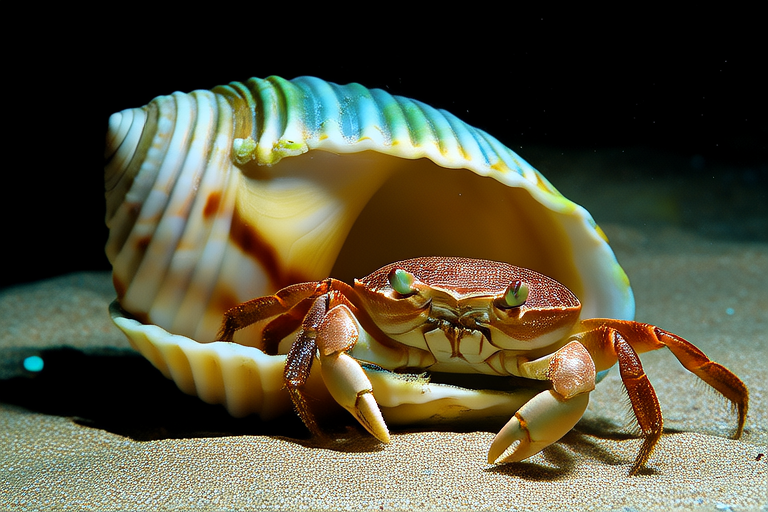Crabby Companions: How Pea Crabs Thrive Inside Their Shells
In the vast ocean, where countless species coexist, there exists a fascinating group of crustaceans known as pea crabs. These tiny creatures have evolved a remarkable lifestyle, living exclusively within the bodies of other marine organisms. This article delves into the world of pea crabs, exploring their unique symbiotic relationships, adaptations, challenges, and the crucial role they play in marine ecosystems.
Introduction to Pea Crabs
Pea crabs, belonging to the family Pinnotheridae, are small, soft-bodied crustaceans that have adapted to live as obligate parasites or commensals within various marine animals. Their hosts include sea cucumbers, barnacles, and bivalves like oysters and mussels. Unlike most crabs, pea crabs do not wander freely across the ocean floor but spend their entire lives within the confines of their hosts. This symbiotic relationship provides pea crabs with shelter, protection, and often nutrients, while the host may receive cleaning services from the crab.
Anatomy of Pea Crabs
The anatomy of pea crabs is uniquely adapted to their sedentary lifestyle. They possess flattened bodies that enable them to fit snugly within the cavities of their hosts. Their carapaces are often elongated and thin, allowing them to move around comfortably inside the host’s body. Pea crabs lack the large claws typical of many crab species, instead having smaller, more delicate appendages that help them manipulate food particles and navigate the internal environment of their hosts.
One of the most notable features of pea crabs is their reduced size. They range from 5 to 20 millimeters in length, making them one of the smallest crab species. This diminutive size is crucial for fitting into the relatively small spaces provided by their hosts. Additionally, pea crabs have a reduced digestive system compared to their free-living relatives, as they rely heavily on their hosts for nutrition.
Entering Hosts
The process by which pea crabs enter their hosts is a delicate and intricate affair. For some species, the young larvae, called megalopae, swim freely in the water until they locate a suitable host. Once they find a potential home, they latch onto the host’s surface and begin to bore through the exoskeleton or tissue, entering the cavity where they will spend the rest of their lives. In other cases, pea crabs are born inside their hosts, hatching from eggs laid by a female crab already residing within the host.
Once inside, the pea crabs must adapt to their new surroundings. They undergo physiological changes to ensure they can survive in the enclosed space, such as developing specialized structures to anchor themselves within the host’s tissues. This adaptation is crucial for preventing them from being expelled by the host’s natural movements.
Reproduction Strategies
Reproduction within the confines of a host presents its own set of challenges for pea crabs. Most species are hermaphroditic, meaning each individual possesses both male and female reproductive organs. This dual-sex capability increases the chances of successful mating within the limited space of the host. When it’s time to reproduce, the crabs release their gametes directly into the host’s cavity, where fertilization occurs. The resulting larvae then leave the host to seek out new homes.
The reproductive strategy of pea crabs highlights their remarkable ability to adapt to their unique living conditions. By ensuring that both sexes are present within each host, pea crabs maximize their chances of successful reproduction, even in the confined spaces of their hosts.
Benefits and Challenges of Symbiosis
The symbiotic relationship between pea crabs and their hosts offers several benefits to both parties. For the pea crabs, the host provides a secure environment protected from predators and harsh external conditions. The host also supplies nutrients, either through direct feeding on the host’s tissues or by filtering the host’s blood or body fluids for organic matter. In return, some pea crab species contribute to the host’s health by removing debris and parasites, thus acting as cleaners.
However, this lifestyle is not without challenges. The cramped quarters can limit the crabs’ movement and access to food. Additionally, the presence of multiple pea crabs within a single host can lead to competition for resources. Despite these challenges, pea crabs have evolved strategies to overcome these difficulties, such as developing specialized feeding appendages and optimizing their metabolism to extract maximum benefit from their hosts.
Impact on Marine Ecosystems
Pea crabs play a vital role in marine ecosystems. As part of the detrital food web, they help break down organic matter, contributing to nutrient cycling. Their cleaning activities also aid in maintaining the health of their hosts, which can be beneficial for the overall balance of marine communities. Furthermore, the presence of pea crabs can influence the behavior and distribution of their hosts, potentially affecting larger-scale ecological dynamics.
Despite their importance, pea crabs face threats from environmental changes, such as pollution, climate change, and overfishing. These factors can disrupt the delicate balance of their symbiotic relationships and threaten the survival of both the crabs and their hosts. Conservation efforts aimed at protecting marine ecosystems are essential for safeguarding the future of pea crabs and the myriad species that depend on them.
Conclusion
Pea crabs exemplify the wonders of nature through their unique symbiotic relationships and remarkable adaptations. From their entry into hosts to their reproductive strategies and the challenges they face, these tiny creatures offer a glimpse into the complex interactions that shape marine life. Understanding the role of pea crabs in marine ecosystems and the threats they face is crucial for preserving the biodiversity of our oceans. As we continue to explore the depths of the sea, let us appreciate the humble pea crab and the vital contributions it makes to the intricate tapestry of marine life.
